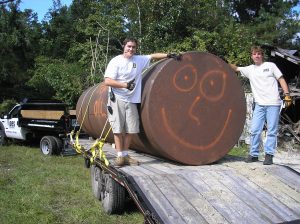Topics
Please also view our General Tank Facts for a wide range of very brief information about oil tanks and related issues.
Initial Concerns
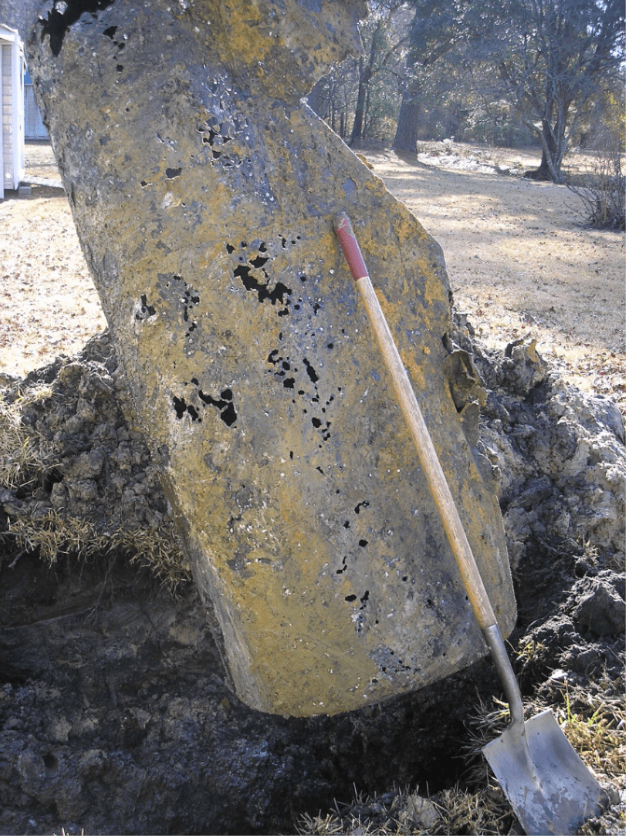
Practical Environmental Solutions can conduct an Oil Tank Search on the property to determine if one is present. For any house built in the 1940’s, 1950’s or 1960’s, it should be assumed that an oil tank is present or that one was there at one time.
So for a house built between 1940 and 1970 the question is: where is the tank or what happened to it?
If the tank was removed but not documented, liabilities remain and the site is not officially closed with the State of North Carolina. Furthermore, if there is no documentation of the tank removal, the buyer should be nervous about buying the property with this huge unknown.
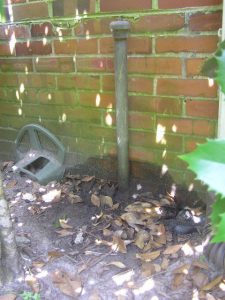
Let our Tank Evaluation prove that you’re right!
Statistically, over 90% of underground oil tanks have leaked. Most were installed in the 1940’s, 1950’s and 1960’s. That’s 60 to 80+ years ago. They have just been in the ground too long.
However, … we still take out clean tanks every year. So maybe your tank hasn’t leaked.
Unless the tank suffers a catastrophic failure, it is almost impossible for a property owner to notice a leak. Usually leaks are so slow that they are not measurable.
If a tank leaked 2 gallons a month for five years, this releases 120 gallons of fuel into the environment significantly contaminating the property. For common size tank, a 2 gallon/month leak may only be a one tenth of an inch drop in fuel level. This change in fuel level would not be observable even using a dip stick. There is no way to monitor how much the furnace is using in a day. So a significant leakage of fuel can occur without being noticed by even conscientious tank users.
“But there’s no water in the tank.” Fuel can leak out of the tank without water accumulating in the tank.
“My plants are growing fine.” Grass, bushes, and trees are rarely distressed by a fuel tank leak. Their roots don’t go deep enough to get into the contaminated soil under the tank.
Tank leaks do not cause an odor in the yard and there is often no land surface indication that a leak has occurred. (Usually contamination is found under the tank which is often 4 to 6 feet below land surface.)
The only way to conclusively show that your tank has not leaked is to remove the tank and check for the soil contamination directly under the tank. Our Tank Evaluation is the only close second.
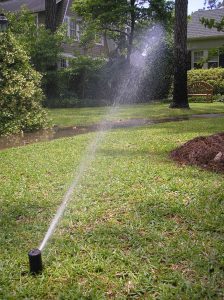 Contamination from your tank can impact your neighbors in ways other than contaminated drinking water wells.
Contamination from your tank can impact your neighbors in ways other than contaminated drinking water wells.
Many people within the city limits use shallow wells to irrigate their lawns, fill swimming pools, and supply outside spigots. A release from your tank could contaminate a nearby irrigation well and “harm” others.
Additionally, underground utilities and be damaged by petroleum contamination. Remember, the contamination caused by the tank can spread far away from the tank. Just because utility wires and sewer lines aren’t right next to the oil tank, they can still be damaged from the spreading contamination.
The State of North Carolina claims ownership of the groundwater under your property. State statutes and regulations only allow groundwater to be “contaminated” up to established levels. This is done to protect human health, the environment, and groundwater resources for potential future use.
If your tank has contaminated groundwater, the State can require the property owner to conduct a cleanup or other activities that they deem necessary.
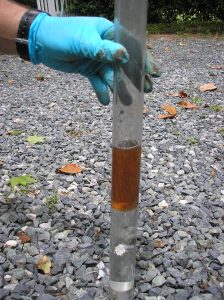
A tank can leak so much that fuel oil actually accumulates and floats on top of the water table. We have measured the following fuel thicknesses in monitoring wells at residential properties:
Over 6 feet of fuel: from a 270 gallon tank
4 feet of fuel: from a 550 gallon tank
3 feet of fuel: from a 270 gallon tank
2.5 feet of fuel: from a 550 gallon tank
2 feet of fuel: from a 550 gallon tank
6 inches of fuel: from a 270 gallon tank
Just to mention some of the more dramatic cases.
While fuel accumulation on the groundwater does not occur under every oil tank, statistics show that it does occur on about 10% of all heating oil tank incident sites.
Even if fuel is not discovered in a monitoring well, groundwater can be contaminated to levels above the State’s standard. If the level is high enough, the State will not allow the use of irrigation wells on the property.
The sooner the tank and contamination are addressed the better chance we can to prevent higher levels of contamination.
Additionally, neighbors could be “harmed” by oil contamination (in groundwater) that migrates off of your property. This could result in lawsuits against you. You may remember the 37 million dollar lawsuit in the Wilmington area several years ago where a leaking gas tank contaminated several people’s drinking water wells.
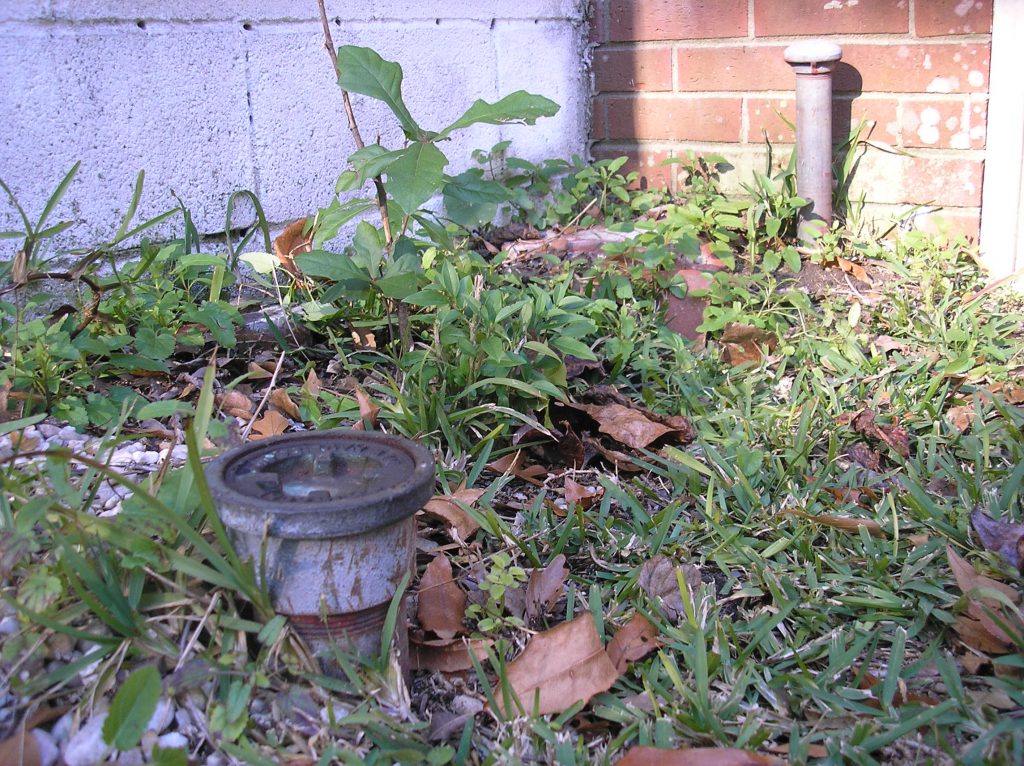
Most oil tanks that are still in-use have been corroding in the ground for 50 to 70+ years, far beyond their life expectancy.
Virtually all of the in-use tanks that we have removed since 2001 were leaking at the time of removal, some with very large holes.
Continuing to use a leaking in-use tank dumps more and more fuel into the groundwater… year after year after year.
Properties with leaking in-use tanks could potentially have larger contamination problems because the tanks are actively leaking. They potentially have leaked more fuel, longer than tanks that have been out-of-use for 20 of 30 years. Our project with over 6 feet of fuel floating on the water table came from a 270 gallon in-use oil tank.
If a tank leaked 2 gallons a month for five years, this releases 120 gallons of fuel into the environment significantly contaminating the property. For a common size tank, a 2 gallon/month leak may only be a one-tenth of an inch drop in fuel level. This change in fuel level would not be observable even using a dipstick. There is no way to monitor how much the furnace is using in a day. So a significant leakage of fuel can occur without being noticed by even conscientious tank users.
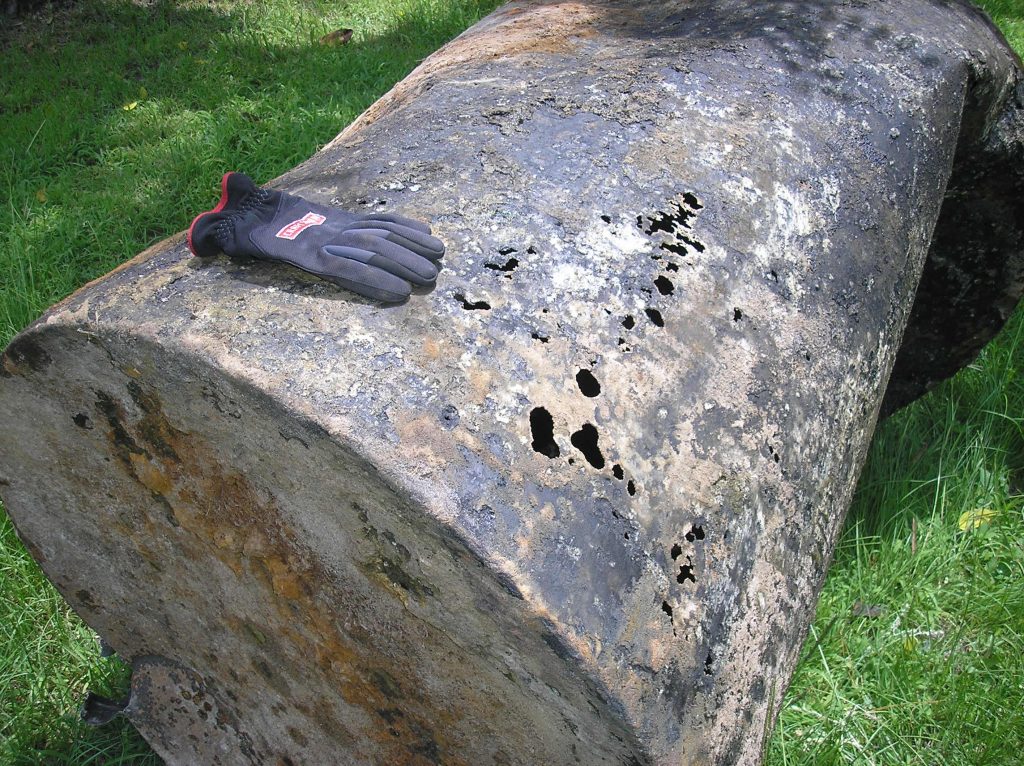
Sellers may mistakenly view these in-use tanks as a property asset because they are using it to store fuel for the oil furnace. We would say that these old tanks are a large liability until proven not to be leaking.
Unfortunately, there is no easy way for a homeowner to accurately assess the current integrity of the tank.
**Ask Practical Environmental Solutions to conduct a Tank Evaluation to determine if the tank has leaked or not.
Obvious holes are discovered in most tanks after removal. This includes tanks that were being used at the time they were removed.
Buyers Beware! Buyers should never view an in-use tank as an asset to the property. An old tank is a liability! Most of these tanks are leaking and are causing contamination problems to grow each day that they remain in the ground.
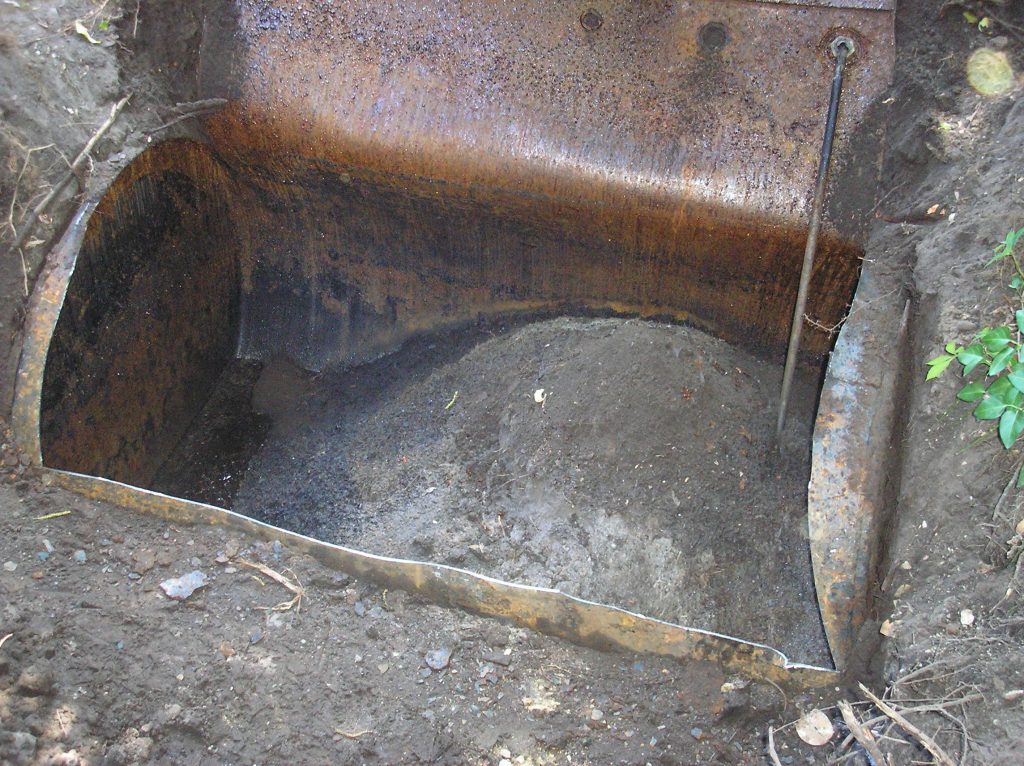
Tanks that are closed-in-place without State approval are not considered “closed” tanks, unless soil samples document that there is no contamination and the tanks were properly cleaned before filling. If a tank can come out of the ground without threatening the house foundation, it should be removed.
Filling a tank with sand (or foam) is a waste of time and money. It doesn’t really accomplish anything.
Sand doesn’t soak up or magically hold the petroleum sludge inside the tank and filling the tank with sand doesn’t address any contamination that has already leaked out of the tank.
Practical Environmental Solutions has properly removed a lot of tanks that were previously filled with sand. The process is more tedious than if the tanks were not filled with sand, but they can still be properly closed to end the liability for the tank.
Sixty years of petroleum sludge that builds up inside the tank is usually not washed out before tank are filled in-place. This leaves a lot of petroleum material in the “filled” tank that continues to leak and create contaminated soil and groundwater.
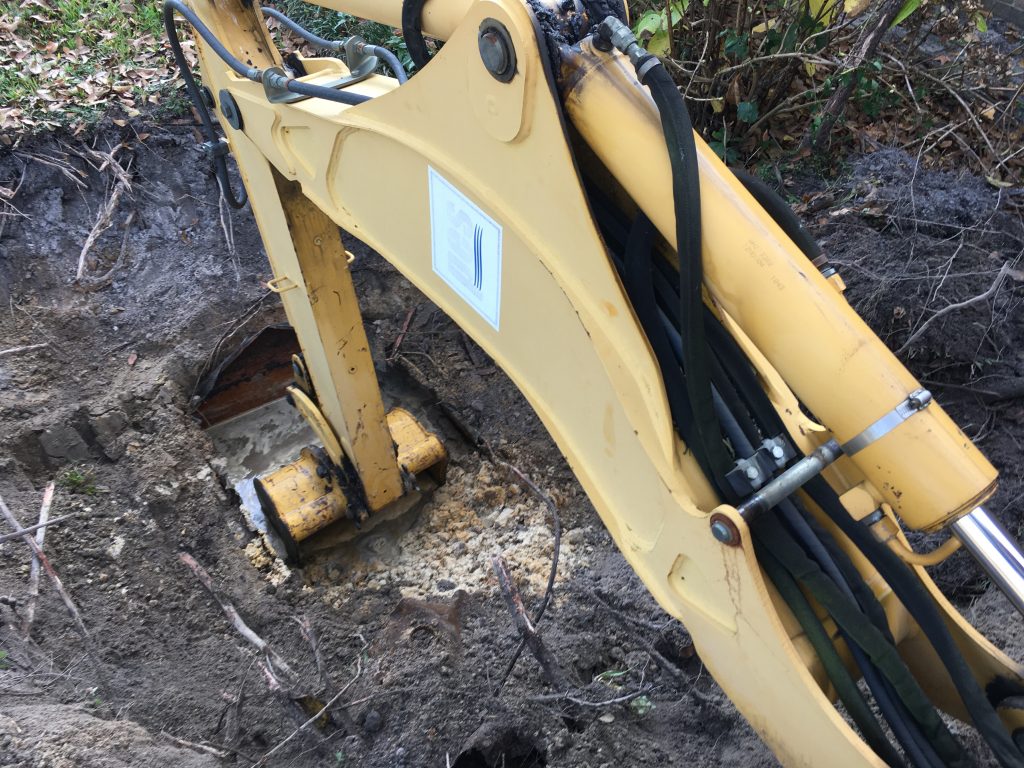
Also, filling the tank with sand does not end the liability for the current property owner (seller) or protect the buyer from assuming the tank and cleanup responsibility.
Simply filling the tank without assessment does not bring the property/tank into compliance with State and Federal statutes and regulations.
Furthermore, to properly clean the petroleum sludge from the tank interior, we must cut open the top of the tank so we can adequately wash and pump it empty. By the time we have done this scope of work, the tank can easily be removed without a lot of additional effort.
Tank removal is preferred by most buyers because it limits their liability and fulfills at least some to the State and Federal requirements.
Buyer Beware! Tank closure without assessment is a very bad situation for a property buyer to purchase. We recommend that you require the seller to conduct a proper tank removal with an assessment before you purchase the property.
No. Practical Environmental Solutions is not required to report anything about your property or situation to anyone. We offer our experience and expertise to help you understand the status and implication of your tank situation.
Our Tank Evaluation will offer you the options available for your specific tank situation so you can weigh the pros and cons and costs of each option.
PES will encourage you to comply with the State regulations and requirements but we will only report information to the State when you specifically authorize us to do so.
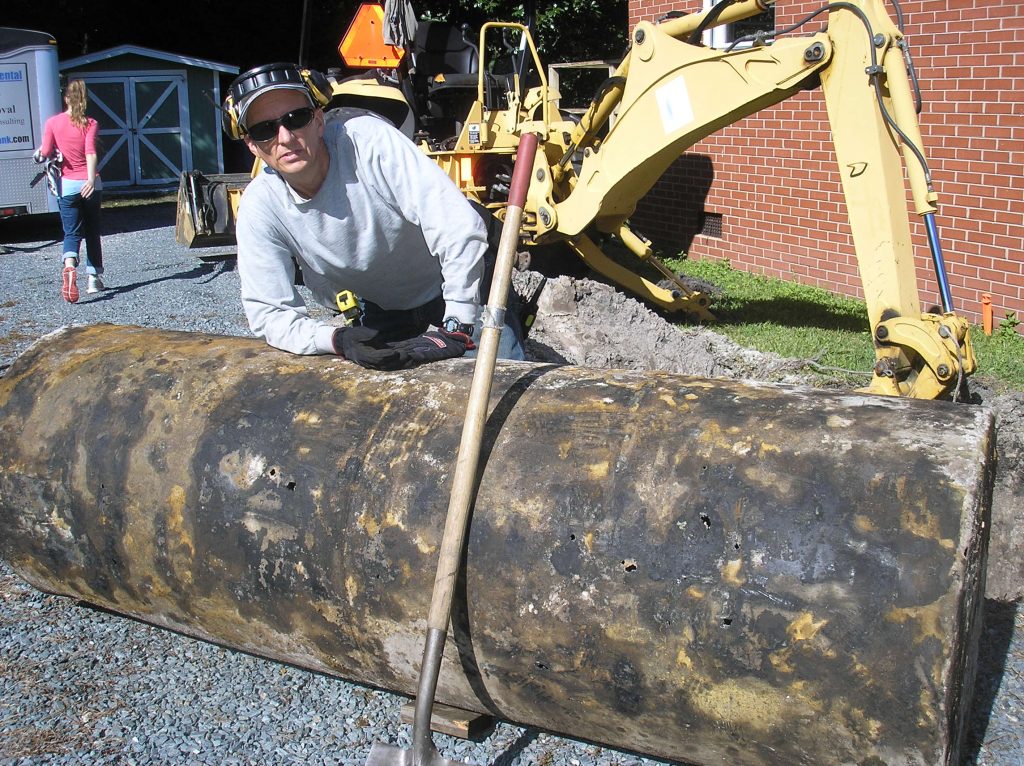
Removal & Cleaning Up
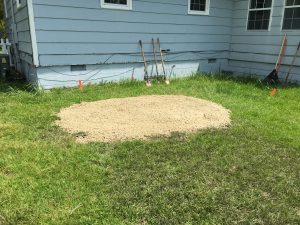
Of course, every yard is different and the yard is the real determining factor.
During our Tank Evaluation, we think through what must be done and then carefully plan how to do that work with the least impact to your yard. Part of our plan tries to anticipate any yard impact so we can consider a yard repair strategy if necessary.
PES owns a small size backhoe that weighs about the same as a small SUV. Occasionally use a rubber track mini excavator. These machines are perfect to conduct the necessary work but leave a lighter footprint than rented equipment that other companies might use. We can also use yard mats to protect the yard when needed.
We can’t conduct the tank removal with helicopters and lasers, but we will make extra efforts so that you are pleased with the end result.
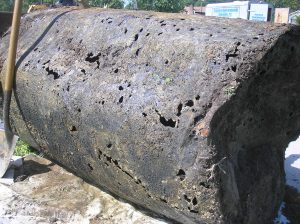
If the tank hasn’t leaked yet it will start leaking eventually. As the contamination grows and migrates off the property, dealing with it will be more complicated and costly. Removing the tank and cleaning up now will be easier and less expensive than removing the tank and cleaning up later.
If you are going to be in the house for a long time, then you are a sitting duck to have to deal with the problem eventually.
If the tank has leaked, the State requires tank removal and other actions whether you are going to sell the property or not.
Furthermore, over 90% of tanks have leaked. Approximately 10% of tank sites have fuel oil floating on the water table. More than 6 feet of fuel oil has been measured at a residential property in southeastern North Carolina.
Are you really comfortable living on top of moving contamination pretending that it’s not going to cause a problem? The fuel and contaminated groundwater will migrate onto neighboring properties threatening irrigation wells and underground utilities.
You are probably sitting on a leaking time bomb. The sooner you de-fuse it the better.
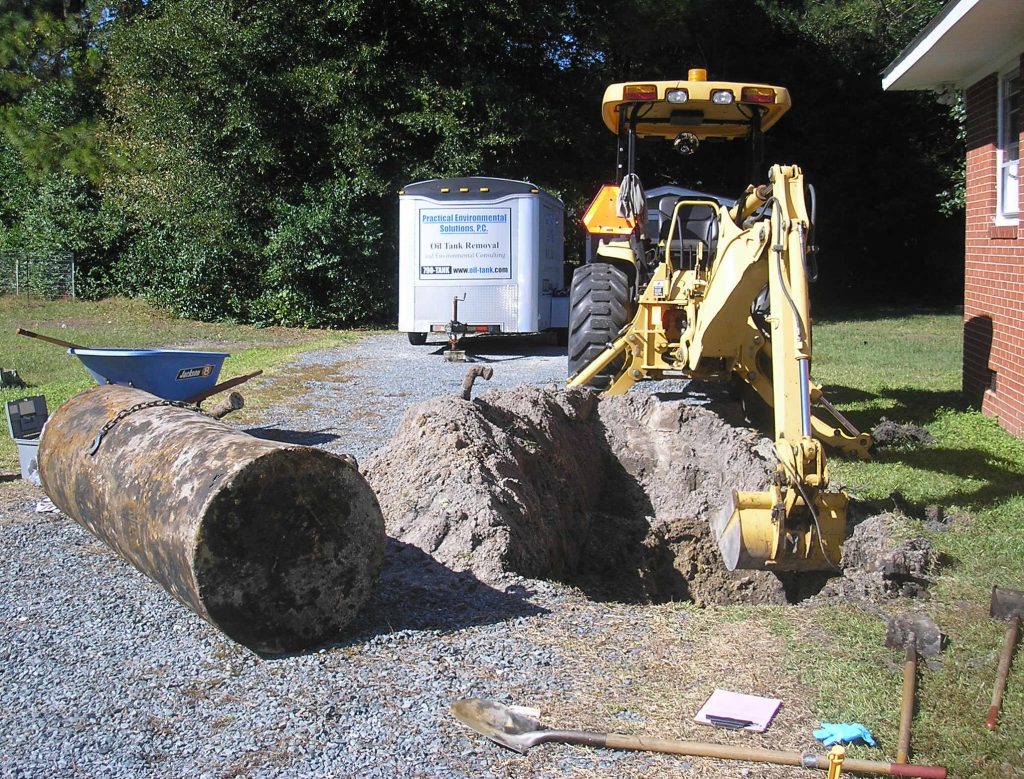
Every site is different because each tank has leaked a different amount of fuel over a different amount of time. Other factors are the depth of the water table and the distance of the tank to the house foundation.
Historically, 1 or 2 “truckloads” have “cleaned up” 70% of residential oil tank sites.
One truckload is approximately 9 yds.3 ”Cleanup” is defined as removing all contaminated soil down to a foot below the apparent water table but leaving soil necessary for proper building foundation support.
We can give you specific guidance on excavation amounts after we conduct the Tank Evaluation.
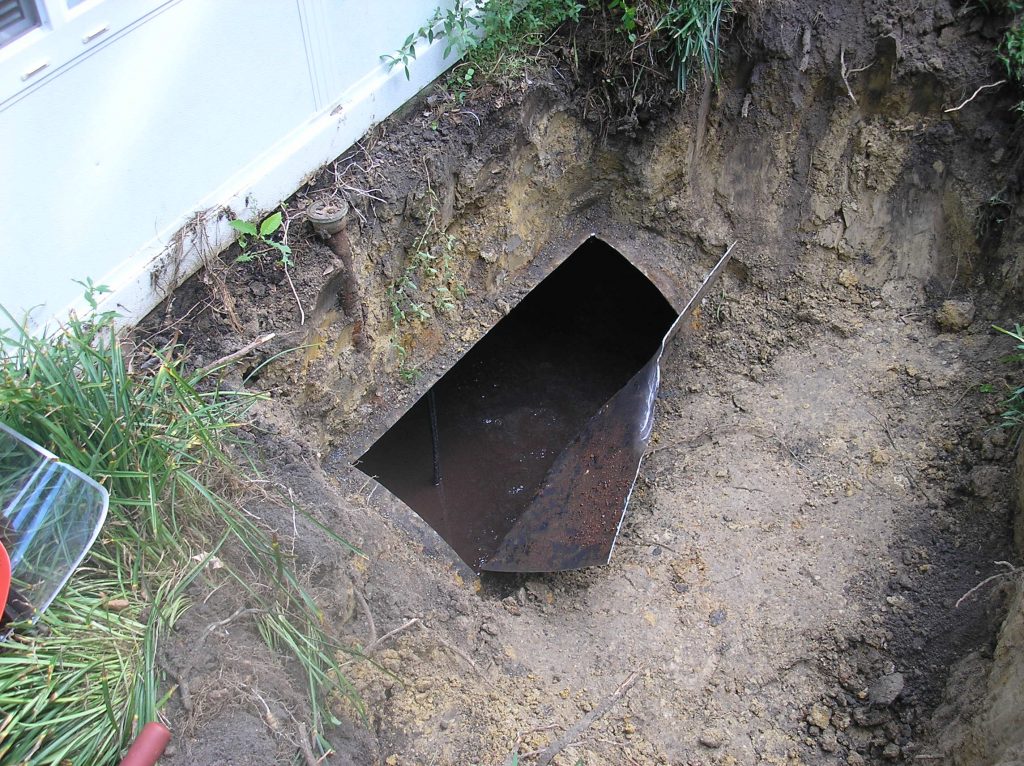
For tanks partially or entirely under a structure foundation, the State will grant permission to properly close the tank in-place. State permission is required to close a tank in-place. After conducting a proper interior tank cleaning, PES fills these “qualifying” tanks with concrete to provide adequate foundation support.
While the State will allow a properly conducted in-place closure for some circumstances, they will also require additional actions if the tank has leaked.
PES can offer several contamination solution options to you after we complete the tank evaluation. Request a Tank Evaluation.
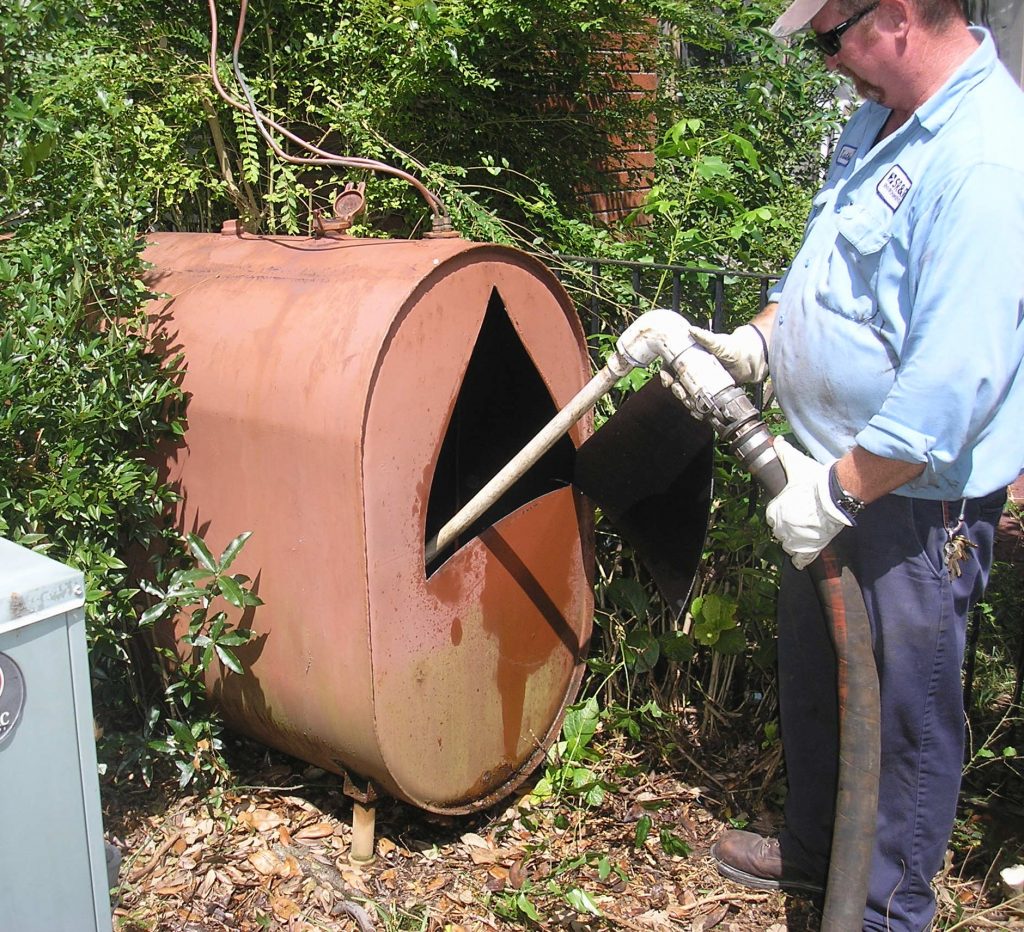
Through the years, PES has conducted many aboveground oil tank removals and contamination cleanups where necessary.
Above ground heating oil tanks are regulated by different rules and guidelines than underground heating oil tanks.
The cost depends on the size and scope of the work required to bring your specific situation into compliance with State requirements and regulations.
If your above ground tank has not leaked, the removal process can be very straight forward and simple to complete.
In most cases, an aboveground oil tank has replaced a leaking underground oil tank.
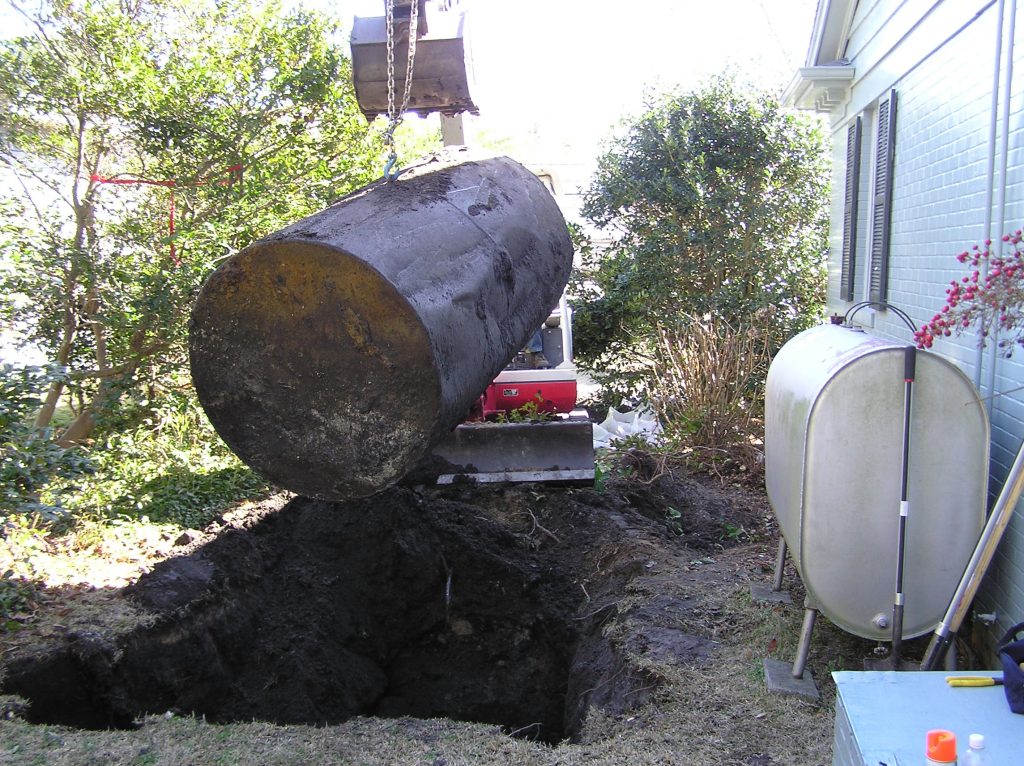
Therefore, most aboveground tank properties require more scope of work than just dealing with the aboveground tank. We typically discount the aboveground tank work when are completing underground tank work at the same time.
You should start with a tank inspection to determine what scope of work is necessary for your situation. Please call us for further information. Request a tank Inspection.
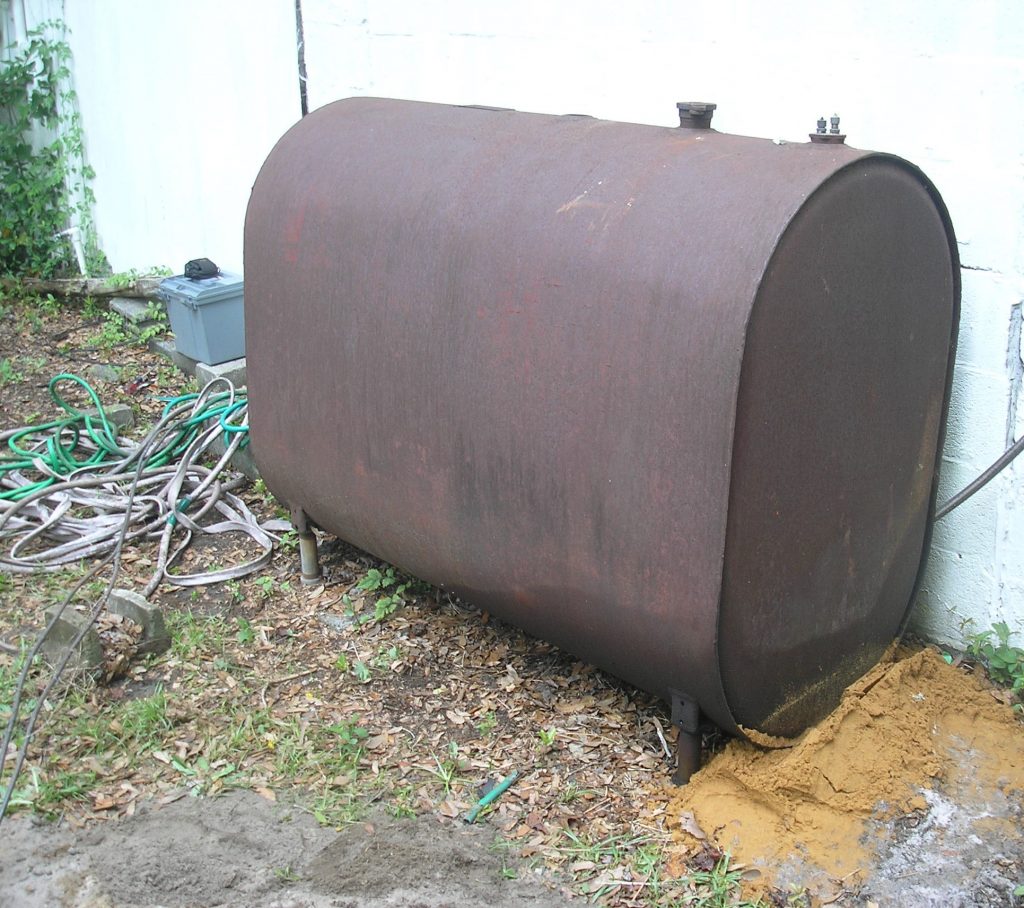
Above ground heating oil tanks are regulated by different rules and guidelines than underground heating oil tanks.
The scope of work necessary and cost depends on the particulars of each site.
PES can complete everything that the State requires to resolve above ground tank situations.
Please call us to discuss your situation further. Contact us.
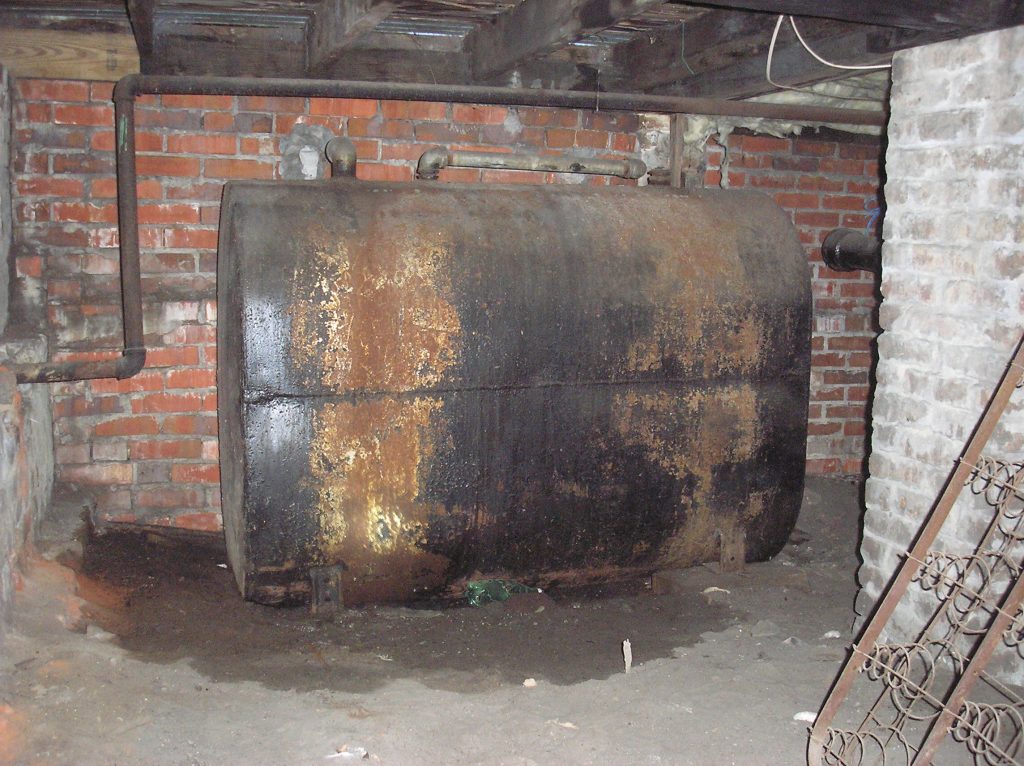
State Compliance
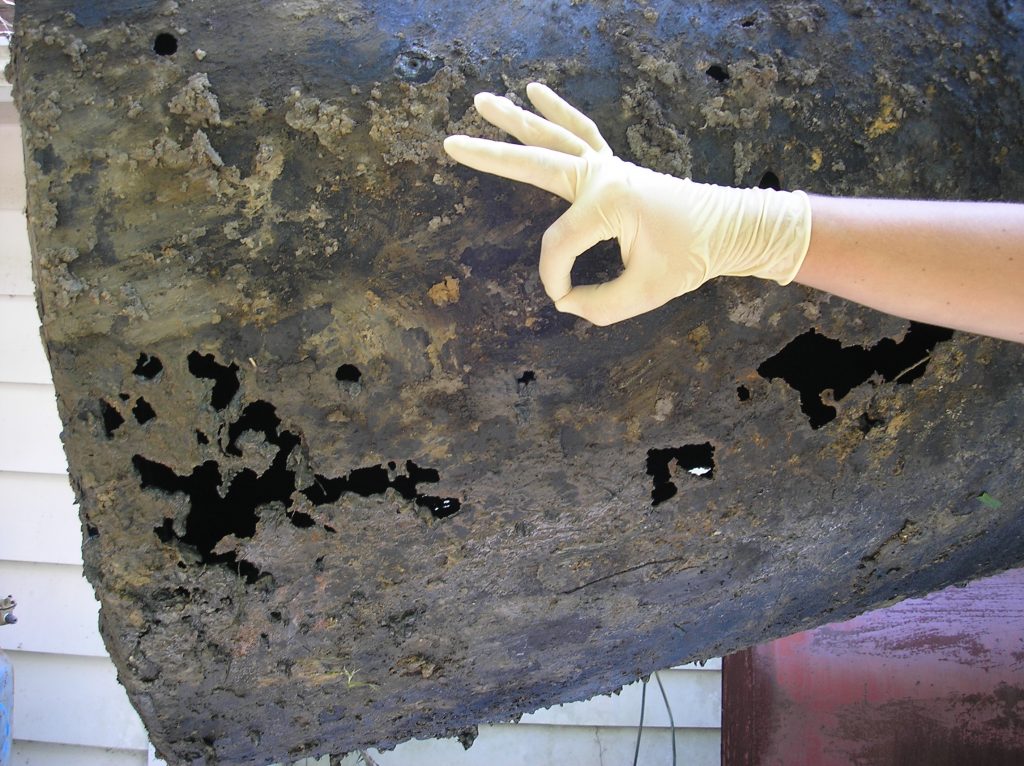
Remember: sellers are responsible for the tank and any associated contamination even after they sell the house.
The State requires action where tanks have leaked contaminating soil and/or groundwater.
There are no State environmental regulations that require specific tank actions just because a property is being sold. However, there may be real estate rules and ethics that apply to this situation.
Nevertheless, educated buyers may not want to buy your property until the tank is properly removed, fully documented, and any discovered release is reported to the State. These actions help keep the buyer from taking ownership and legal responsibility for the tank.
Why would a buyer take on the legal liability and financial responsibility by buying someone else’s leaking tank problem?
Because North Carolina statute and regulation definitions make every property owner a tank owner, sellers will remain responsible for the tank and any associated contamination … until the tank is properly closed/removed. Therefore, a seller could be required to clean up a tank years after they sold the property, even for a leak that didn’t occur until after they sold the property.
Property Owners: To protect yourself from this endless liability, before you sell the property you should either:
1) remove the tank and end the liability once and for all, for everyone or
2) have the tank evaluated to document that the tank did leak while they owned the property. If the tank is not removed, any leak found later must have occurred while a different person owned the tank.
Remember, over 90% of all underground oil tanks have leaked causing contaminated soil and possibly contaminated groundwater. This contamination problem will continue to spread over time creating a bigger problem over time.
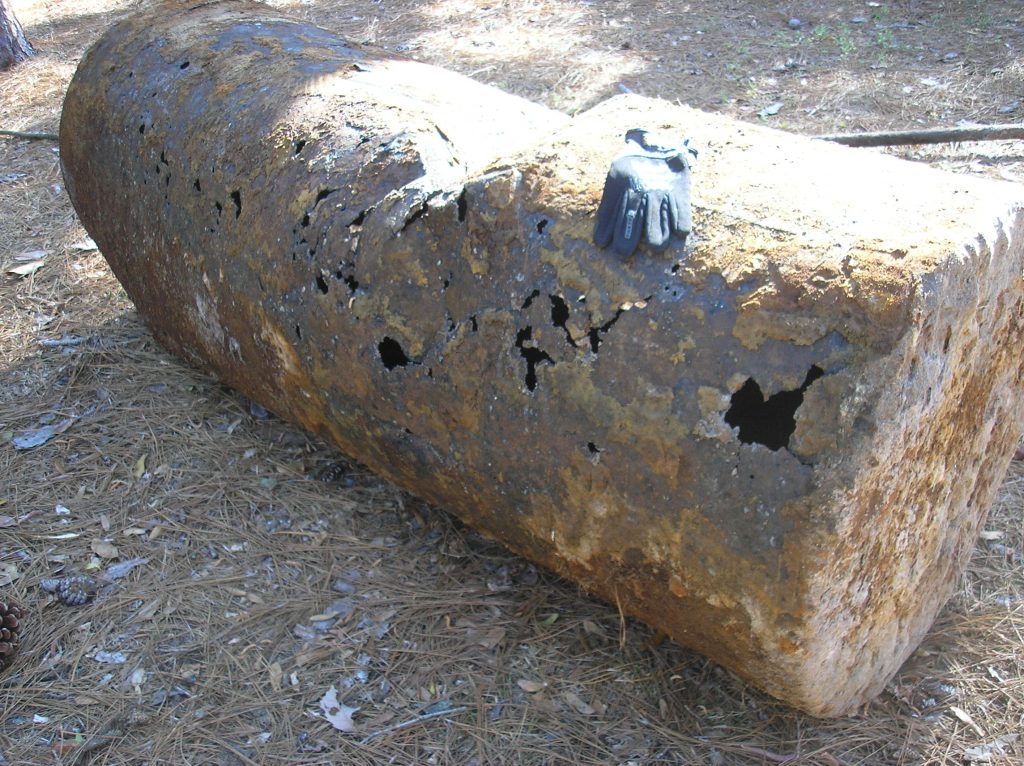
Filling a tank with sand (or foam) is a waste of time and money. It doesn’t really accomplish anything.
The State requires that leaking tanks be removed but will give written permission to close a tank in-place if a tank is under a house foundation.
Tanks that are closed-in-place without State approval are not considered “closed” tanks, unless soil samples document that the tank has not leaked. If a tank can come out of the ground without threatening the house foundation, it should be removed.
Sand doesn’t soak up or “hold” the petroleum sludge caked on the inside the tank and of course filling the tank with sand doesn’t address any contamination that has already leaked out of the tank.
Practical Environmental Solutions has properly removed a lot of tanks that were previously filled with sand. The process is more tedious than if the tanks were not filled, but they can still be properly closed to end the liability for the tank.
It’s our experience that the petroleum sludge that built up over 60 years was not usually washed out before they were filled. This leaves a lot of petroleum material in the tank that will continue to leak out and create contaminated soil and groundwater.
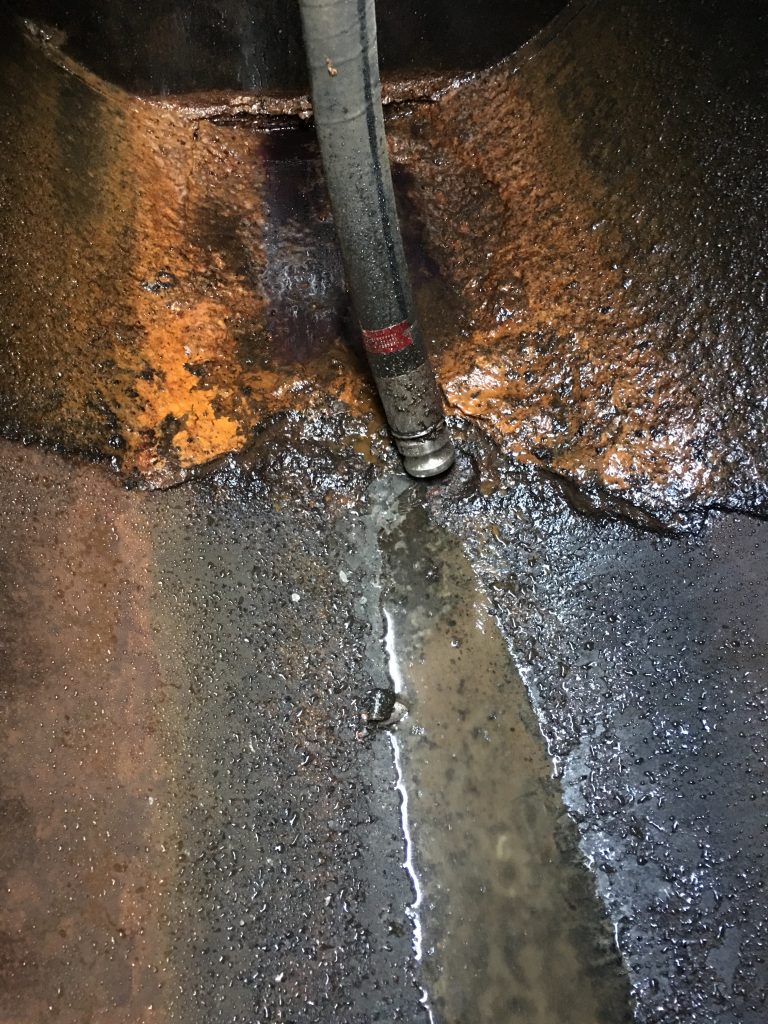
Also, filling the tank with sand does not end the liability for the current property owner (seller) or protect the buyer from assuming the tank and cleanup responsibility.
Simply filling the tank without assessment does not bring the property/tank into compliance with State and Federal statutes and regulations.
Furthermore, to properly clean the petroleum sludge from the tank interior, we must cut open the top of the tank so we can adequately wash and pump it empty. By the time we have done this scope of work, the tank can easily be removed without a lot of additional effort.
Tank removal is preferred by most buyers because it limits their liability and fulfills some of the State and Federal requirements.
Buyer Beware! Tank closure without assessment is a very risky situation for a property buyer to purchase. We recommend that you require the seller to conduct proper tank removal and soil assessment before you purchase the property.
You should help select the environmental consultant doing the tank removal since you are ultimately left with the consequences long after the seller is gone.
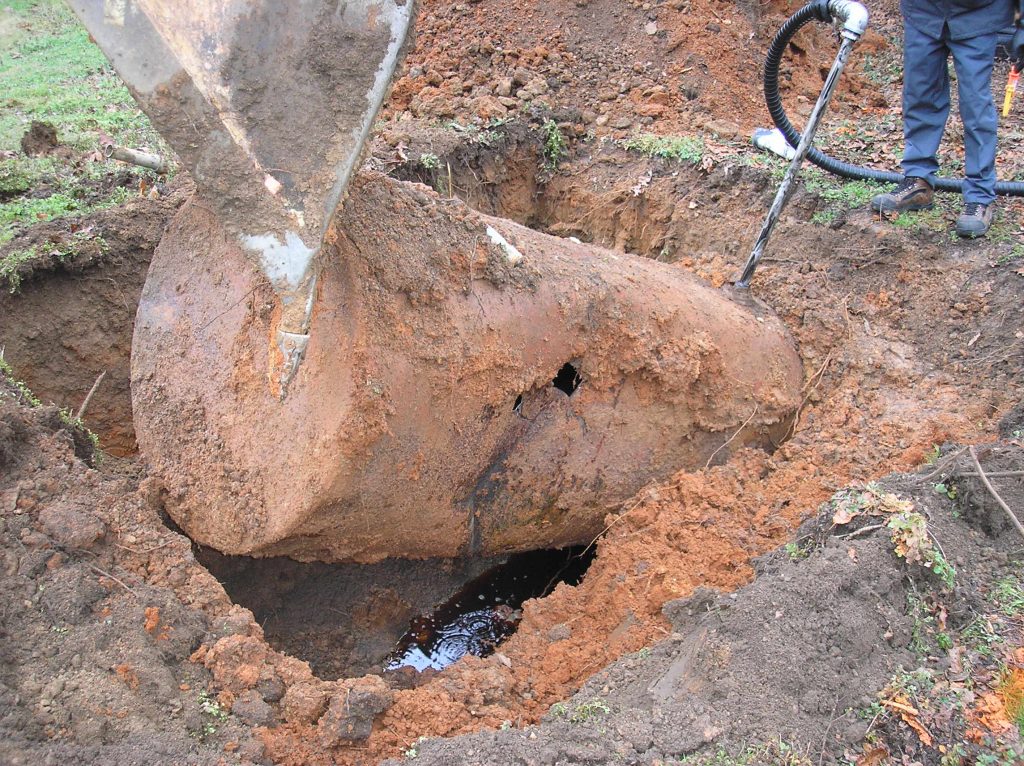
Over 90% of heating oil tanks have leaked. When someone says “We took out the tank and it didn’t look contaminated.” That’s probably a reason to be concerned.
Look closely at their Tank Closure Report. (They probably don’t have one.)
We recommend that buyers verify clean closures with a second opinion because they are relatively rare.
If a tank really didn’t leak, documenting it with a soil sample and a professionally sealed Tank Closure Report will make the tank a “non-issue.”
If the tank did leak, the contamination can possibly be cleaned up to make the leaking tank a “non-issue.” However, the longer you wait to address the tank, the more the contamination spreads making it more difficult and more expensive to clean up.
However, even a partial cleanup is good, because it removes the worst of the contaminated soil, lowering the overall concentration, and helping to slow the spread of contaminated groundwater.
** Groundwater is always moving, migrating onto neighbors’ properties and any present irrigation wells and underground utilities.
To end your liability for the tank and contamination, you either need to:
report to the State as required and complete the “Incident Closure” process to obtain a State “No Further Action” letter or have a soil sample and a tank closure report proving that the tank didn’t leak.
Not looking for contamination doesn’t give you either and your liability remains. Leaving contamination behind after removing a leaking tank could become a bigger problem for you long after you sell the house because the contamination continues spreading and moving.
Your tank and contamination responsibility does not end simply by selling the house. You need a “No Further Action “ letter from the State “signing off” on any contamination left after removing the tank or documentation showing that the tank did not leak.
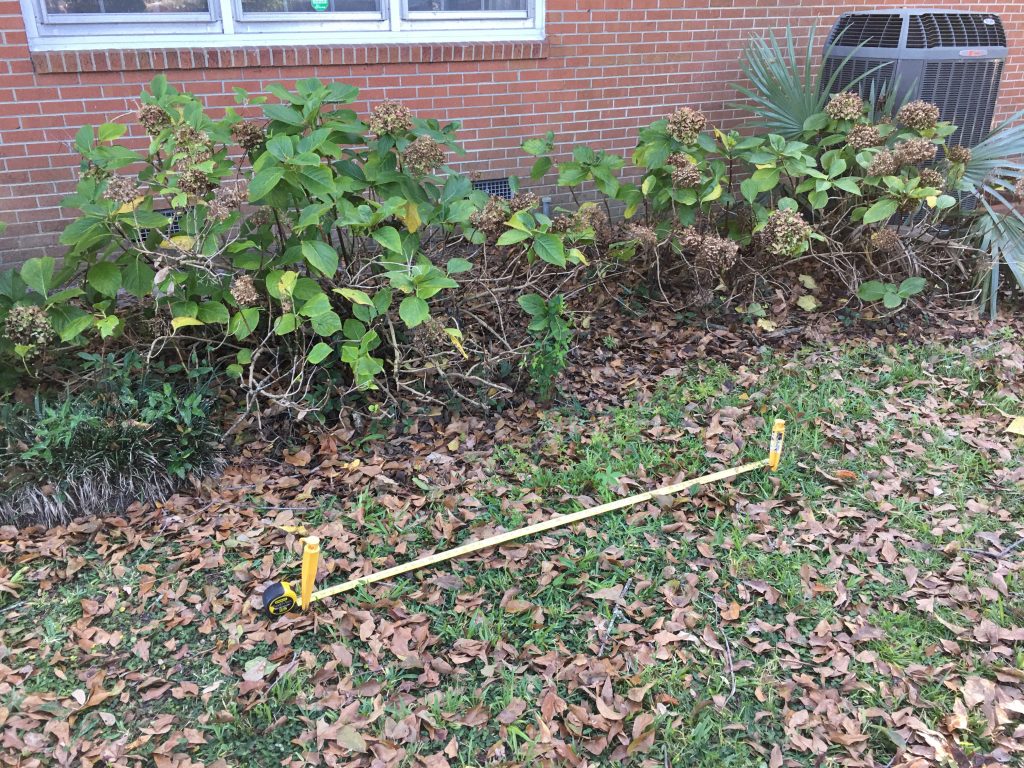
Missing pipes may make it harder to find, but remember a metal detector search will still find the buried tank.
Although this may not be illegal, real estate ethics require the disclosure of underground oil tanks.
A wise property buyer will require some documentation that the tank was properly removed and checked for leaks. If this is not available, a careful buyer will request PES to conduct a metal detector survey of the property to find the tank.
It won’t look very good that you hid the tank and did not disclose it. There could even be legal actions taken against you. You’ll probably lose that buyer and will have to disclose the tank to the next potential buyer.
Whether the tank is discovered or not, an unresolved tank (no adequate documentation of a proper closure) may devalue your property.
Additionally, your tank responsibility will not end simply by selling the house, even if you never used the tank.
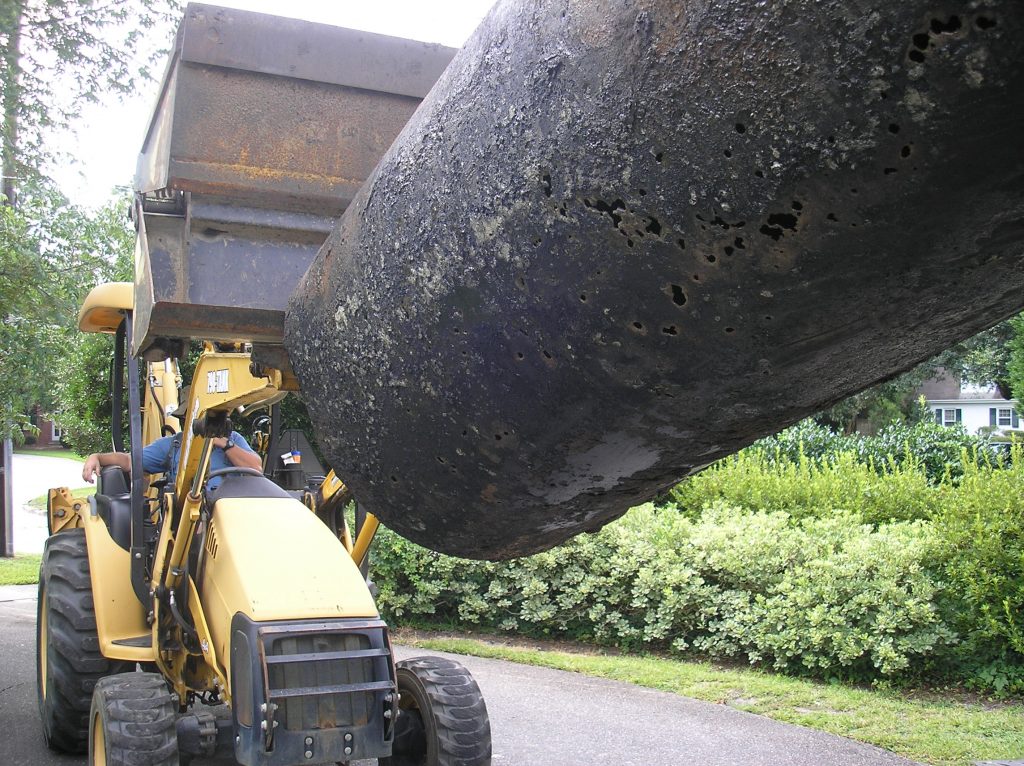
Quite simply, you are not legally responsible for every tank in the neighborhood, just your tank. The State is not going to enforce you to remove and clean up every tank in the neighborhood, just your tank. Your buyer, your mortgage company, and your insurance company aren’t concerned about every tank in the neighborhood, just your tank.
It’s important that you limit your liability and protect yourself. Whether your neighbor is protected or not, well, that’s not your problem, … unless their tank has leaked and contaminated your property.
Your tank, your problem, your liability.
Practical Environmental Solutions can help you limit your liability. Let us show you how.
Why Choose PES
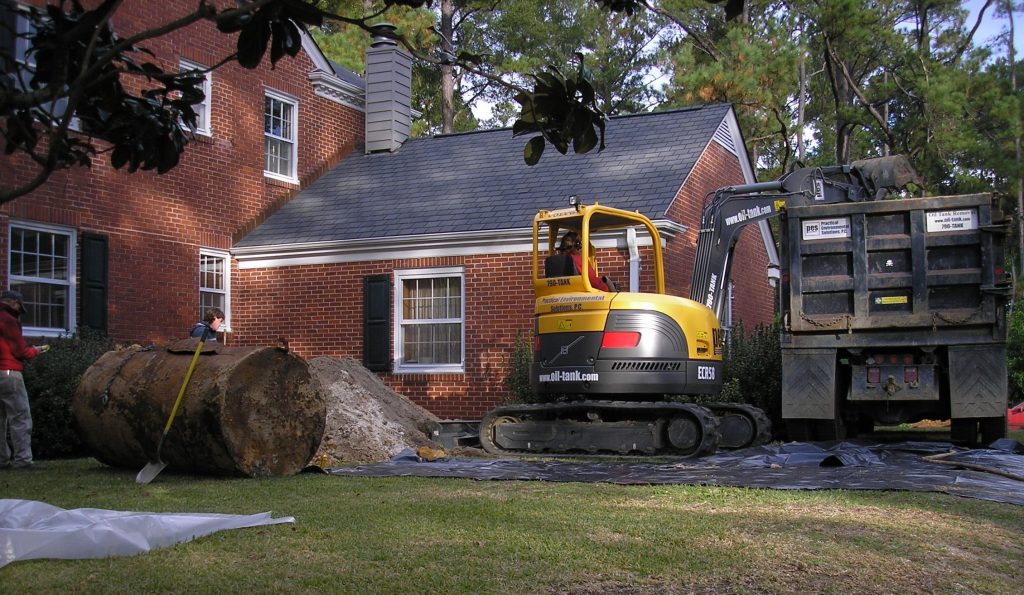
Since 2001, Practical Environmental Solutions has removed hundreds of oil tanks mostly in Southeastern North Carolina, more than any other company in the area. We remove additional tanks every month. We are experienced, licensed, insured, and offer turnkey solutions for your oil tank situation.
Other companies may have removed a tank before, but how many tanks did they remove in the past 3 months? PES keeps sharp with this process because we remove tanks every month.
Do other companies really have a plan designed to address the specific needs of your site and to comply with the State regulations? Or do they just show up and figure it out as they go.
Hundreds of tank removals have taught us well.
And there’s no substitute for that learning curve.
Remember the main purpose of removing the tank is to conclusively end your environmental liability. To do this you must conduct a proper tank removal and have everything documented by a licensed geologist. Our State licensing gives you an additional level of accountability for the work that we perform.
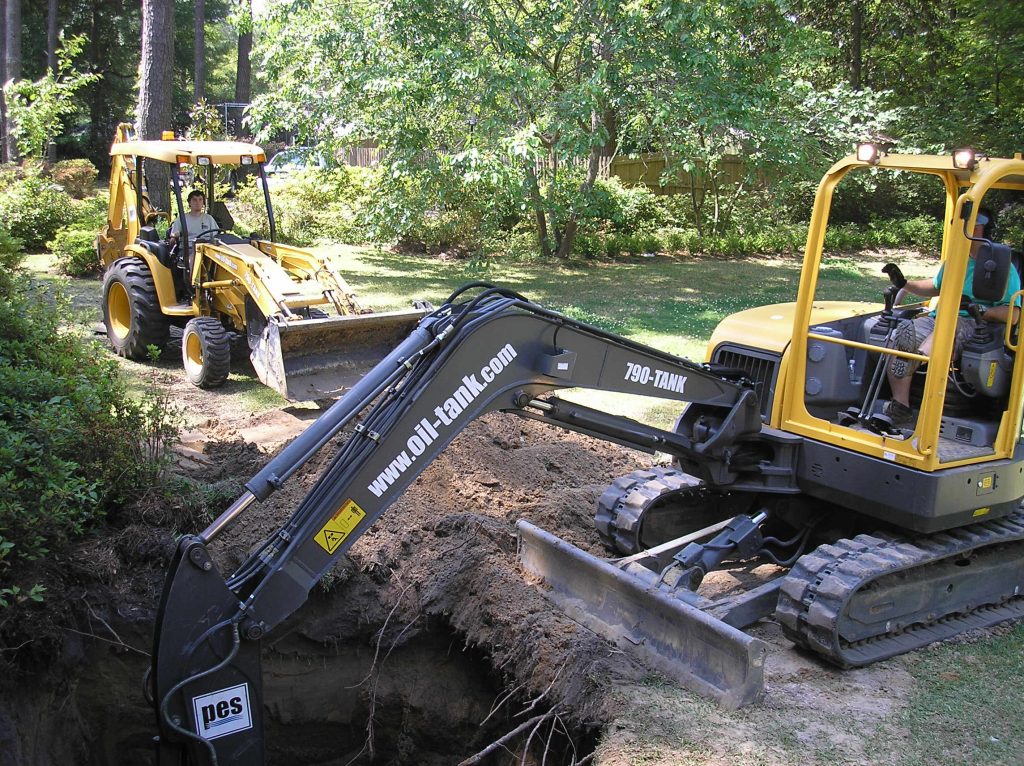
Of course, price is a consideration but be careful!
The purpose of removing the tank is to conclusively end your environmental liability not to get the cheapest deal from someone who may or may not know what they are doing.
To end your liability your consultant must conduct a proper tank removal, assess for contamination thoroughly, and have everything documented for future review. Because PES is professionally licensed by the State of North Carolina, you receive an additional level of accountability for the work that we perform.
“Billy Bob Backhoe” or “We Try Anything Consulting” might “save” you a few hundred dollars doing a sub-standard tank removal, but it might cost you thousands of dollars later when are forced to correct some issues on the tank closure documentation or the contamination cleanup. It is possible that this could occur even after you no longer own the property, but are still legally responsible.
Some companies give a low price so you will sign a contract but then they add extra items after the fact because they forgot or maybe that how they get clients. They leave off items on their first estimate to keep the cost down knowing that they can add them later when you are committed to them to do the tank removal. PES offers a firm price estimate and wants your satisfaction with the entire process.
Also, be sure that you are comparing “apples to apples.” In our experience, a company that offers to remove your tank for less than PES is cutting corners. They may not be able to provide you with a professionally sealed tank closure report that documents the tank and contents disposal or a conclusive soil assessment. These items are necessary components to end your tank responsibility.
Most other reputable professional environmental companies charge considerably more than PES to conduct a proper oil tank removal. We can keep our costs down by conducting all work “in-house.” We own our own specialty equipment. We know how to be very efficient because we have done hundreds of tank removals.
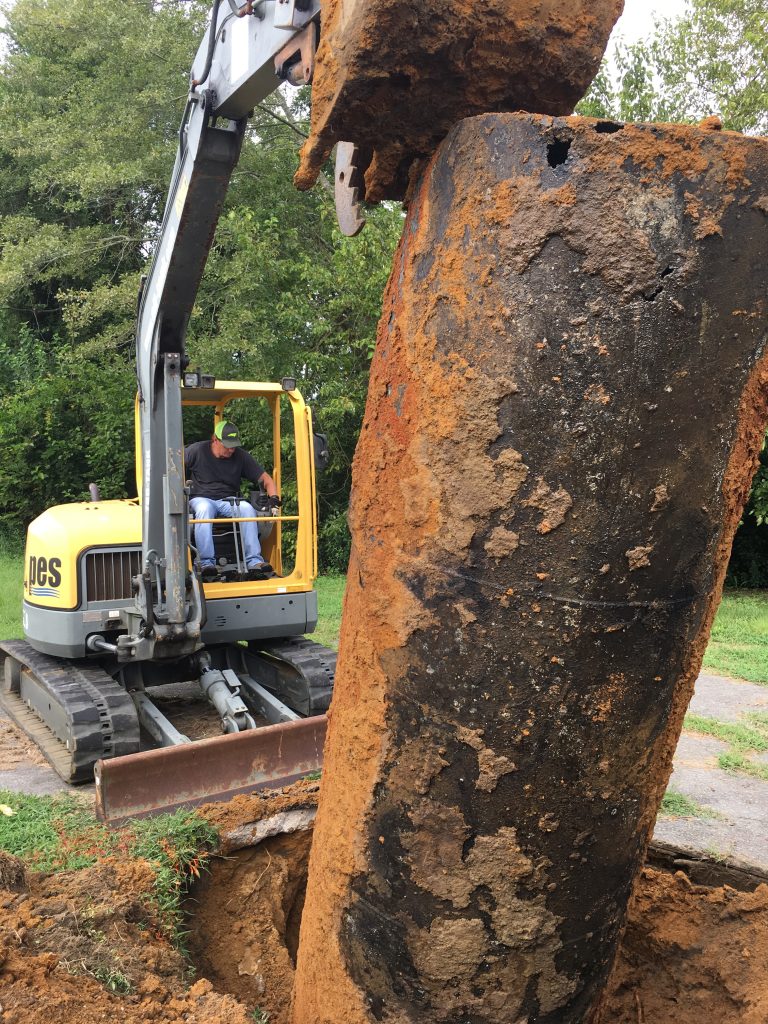
Just because someone can operate a backhoe, doesn’t make them qualified.
Just because they have a geology or engineering license, doesn’t make them qualified.
To end your tank and contamination liability and conduct efficient site work, your environmental contractor needs to be licensed and experienced.
Practical Environmental Solutions has removed hundreds of oil tanks mostly in Southeastern North Carolina since 2001, removing additional tanks every month.
Other companies may have removed a tank before, but how many tanks did they remove in the past 3 months?
Do they really have a proven plan designed to address the specific needs of your site and comply with the State regulations?
Hundreds of tank removals have taught us well.
There is no substitute for that learning curve.
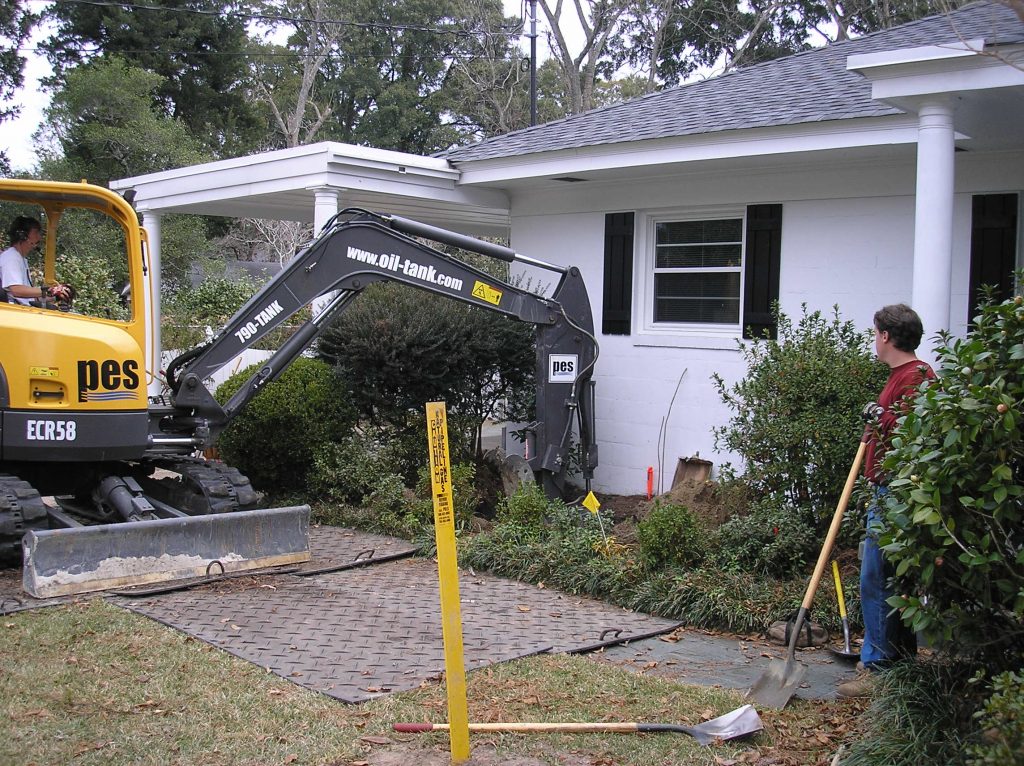
License? YES.
You need a licensed professional to help you acquire a “No Further Action” letter from the State to officially close the tank incident. The State only accepts samples and reports from licensed geologists and engineers.
Experience? YES, crucial.
An inexperienced contractor can cause a big mess by doing something as small as spilling fuel oil during the removal or by doing something as major as not meeting the State’s requirements. Complying with the State’s regulations and guidelines is important to end your liability. There are worse ways and better ways to communicate with the State.
PES has removed hundreds of oil tanks since 2001. We have learned a lot since our first tank removal. How to be clean, how to be careful, how to be efficient, and how to best navigate the State regulations and requirements.
We bought the perfect equipment to conduct oil tank removals and contamination cleanups on residential properties.
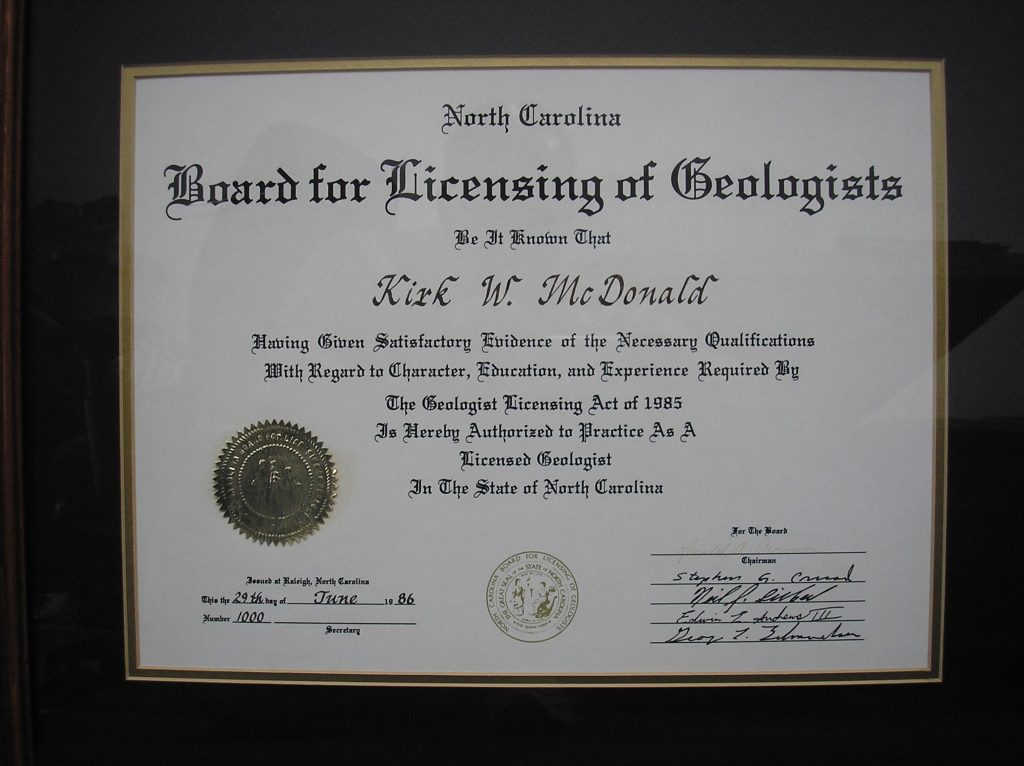
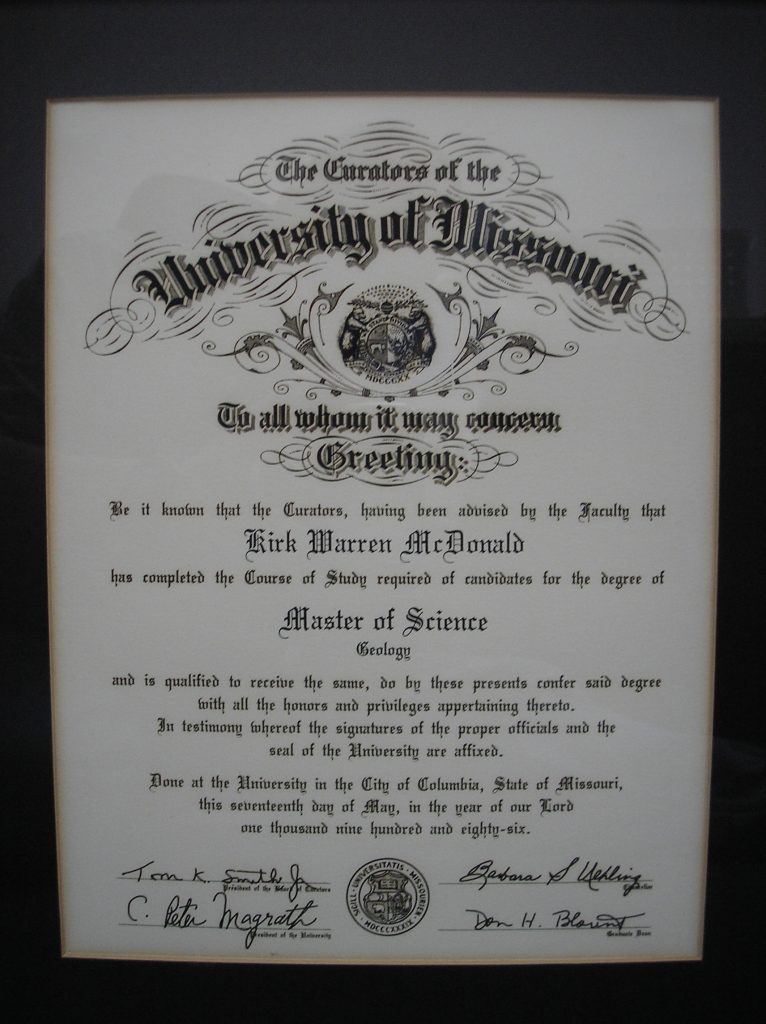
Yes. Kirk McDonald is a licensed geologist in the State of North Carolina (#1000). PES is also a licensed Geological Corporation (C-348). The State requires that samples be collected by a licensed geologist. Additionally, all official reports and documents must be sealed by a licensed geologist.
And yes. We are fully insured. General Liability, Workman’s Comp, Automobile. We have insurance but we have never used it. Think before acting and “Safety first.” Insurance certificates are available upon request. We also carry an insurance certificate on all subcontractors (dump trucks, vacuum trucks, etc.)
PES is only licensed to consult and remove tanks in North Carolina. Although most of our tank removals have been in southeastern North Carolina, we are available to serve all of the state.
Wilmington, Fayetteville, Jacksonville, Raleigh/Durham, New Bern, Kinston, Lumberton, Goldsboro, Laurinburg, and all places in between.
However, if you are having trouble finding a tank removal contractor or environmental consultant that you trust and feel good about, give us a call and let’s see how PES can help you resolve your tank situation.
